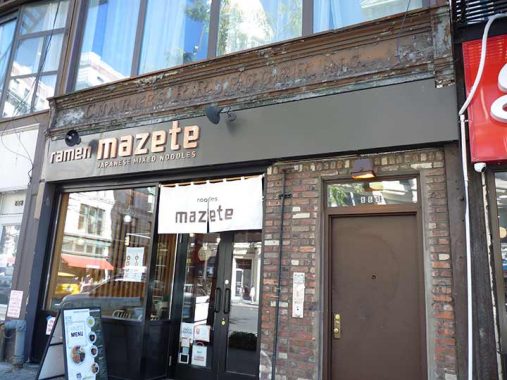
THE influence of Charles R. Ruegger can be found on 6th Avenue between West 20th and 21st Streets decades after his brief dominance. That’s what happens when you install quality signage that generations of subsequent businesses either can’t or find it too much of a pain in the neck to remove. In October 2024 I was heading down 6th Avenue in an area where I have worked frequently over the years and once again spotted a sign for Ruegger’s establishment, Bazar Français.
A charming cluster of 4-story buildings can be found on the east side of 6th Avenue between West 20th and 21st Streets. According to real estate records, they were built around 1850, in the years following the coming of the Episcopal Church to the area. In the middle is #666 6th, something of an ironic number considering the proximity of the old church.
A pair of pressed metal signs can be found on the pediment and above the second floor, noting the former Bazar Français and its owner, Charles R. Ruegger, which I imagine was pronounced “roo=ZHAY.” Though 1929 seems a little past the area for such signage, here’s a wonderfully preserved sample of the art.
According to Tom Miller, Daytonian in Manhattan, Ruegger had already been in business in NYC for 55 years, since 1874, by the time he moved his Bazar Français to 666 6th.
In March 1929 Ruegger purchased the building from Samuel and Nettie Lichtman. The Times reported that “It is to be extensively altered and occupied by Mr. Ruegger for his business of hotel, club and restaurant equipment.” Among the alterations was the removal of the unsightly fire escape to the rear of the building.
Around this time Ruegger opened a shop nearby on 19th Street for the manufacture industrial metal such as ducts and ventilators. The 78-year old Charles Ruegger died in 1931. He had not only created a successful business in the Bazar Francais but was mayor of Woodridge, New Jersey, for two consecutive terms. His son, Charles Jr., continued running the business.
After World War II the firm would produce its own line of copper and brass cookware. The Bazar Francais continued to offer imported kitchen ware as well as its own high-end goods, becoming the first gourmet outlet in the country. Along with small items like butter brushes, the firm offered decorative and hard-to-find articles like the 1956 nickel-plated wine rack “that completes the apartment dweller’s suburban-scorning life.”
Bazar Français closed in 1975 but the signs are still on the building, as well as a fading-fast painted ad on the north side of the building.
6th Avenue in this neighborhood, and on this block, is quite interesting: you will also find the Episcopal Church of the Holy Communion, which doesn’t seem to get any publicity as one of the oldest church buildings in NYC since it was built in 1820. Of course, most of its publicity comes from its later incarnation as the drug and sex-fueled disco, Limelight.
As mentioned I have worked in this area over the last 40+ years. My first job in print as a reader for a book printer called Lexigraphics was at #150 5th Avenue in 1981. It was my last job on the daytime shift for almost a decade. More recently, around the corner on #37 West 20th, I worked for a printer called Medallion Retail. This was a bizarre situation in which I was kept waiting to be hired as we went back and forth for three months. Finally the candidate they wanted dropped out and they brought me in. For whatever reason the atmosphere was quite hostile and I was gone at the 3-month mark in early 2012, before they had to pay my health insurance. It’s all fine, I co-published my second book, “Forgotten Queens,” the next year.
As always, “comment…as you see fit.” I earn a small payment when you click on any ad on the site. Take a look at the new JOBS link in the red toolbar at the top of the page on the desktop version, as I also get a small payment when you view a job via that link.
12/27/24
